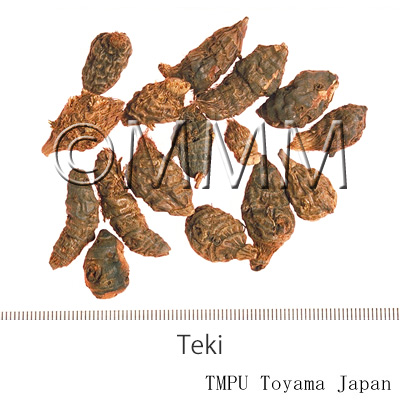Crude drug sample data base
※Click on the image to enlarge it.
The capital city, provincial capital city or the representative
location of its administrative area is indicated.
location of its administrative area is indicated.
Production area information
https://ethmed.toyama-wakan.net/img/pin_san.png
-6.9174639
107.61912280000001
Collection information
Republic of Indonesia,West Java Province
https://ethmed.toyama-wakan.net/img/pin_nyu.png
Scientific information data base
| Crude drug name | Indonesian name, English name | Teki | ||||
|---|---|---|---|---|---|---|
| crude drug image |
| |||||
| Original plant name | Cyperus rotundus Linn. | |||||
| Family name | Cyperaceae | |||||
| Used part | Tuber | |||||
| Distribution area | It is thought to originate from Africa. In Java it grows as a weed in cropped lands,gardens, from lowland up to 1000 m altitude [201]. | |||||
| Description | Rhizomes and tubers are white and fleshy when young and some become firmly packed with starch. On aging they darken and harden. The plant is a perennial or annual herb, tufted or creeping rhizome or stolons, sometimes with tubers at intervals. They taste and smell just like spice, rather bitter. Stem erect, solid, usually leafy at the base. Leaves tristichous, narrowly linear, 2-4 mm wide and up to 60 cm long, dark green in color, grass-like. Inflorescence terminal, umbel-like or capitate; flowers bisexual. Fruit a sessile or short-stalked nut, trigonous or lenticular [205]. | |||||
| Drug effect | Analgesic, anti-inflammatory, stomachic, sedative, diuretic, diaphoretic, carminative [231]. | |||||
| Specific actions | Diuretic, digestive, carminative, anti-inflammatory [231]. | |||||
| Frequency in use | Moderate | |||||
| Pharmacological effect | Advances in the study of chemical constituents and pharmacology of Cyperus rotundus L. have been conducted [PMID: 12956182]. C. rotundus showed antimalarial activity in an in vitro and in vivo tests. The essential oil has nematicidal and insecticidal activity. It also has insect-repellent activity which is comparable to citronella oil [205]. The ethanolic extract of the root has anti-inflammatory and /or anti-pyretic effects. It was found that the mechanism of its activity was to be inhibition of prostaglandin synthesis [205]. Study is carried out to investigate the antidiarrhoeal activity of the methanolic extract of Cyperus rotundus rhizome and its fractions in castor oil induced diarrhoea in mice. The extract given orally showed significant activity, while the ethyl acetate fraction did not show any effect [PMID: 16376024]. Study on the inhibitory effects of methanol extract of Cyperus rotundus rhizomes on nitric oxide and superoxide productions by murine macrophage cell line showed that the extract could be developed as anti-inflammatory candidate for the treatment of inflammatory diseases mediated by overproduction of NO and O2 [PMID: 11378282]. | |||||
| Medical system | Indonesian medicine (Jamu) | |||||
| Traditional usage | Fresh crushed tubers are used to treat oedema and urinary calculus. Together with Centella asiatica and roots of Imperata cylindrica they are used as a potent diuretics. Decoction of tuber is used to promote regular menstruation and leucorrheal discharge. The dried powdered form is sprinkled and is a good remedy for wounds; the infusion can be used as gargle [201]. | |||||
| Formulation | 1) Edema: 5 pieces of tuber, 1 handful of fresh Orthosiphon stamineus leaves, 1 handful of aboveground parts of Centella asiatica, 5 pieces of young Imperata cylindrica roots, are boiled with 110 ml of water. Stand to cool, strain. Drink 100 ml of the decoction once a day for 14 days [231]. 2) Rheumatism: 4 grams of tuber and 2 grams of celery seeds are boiled with 110 ml of water for. 15 minutes. Stand to cool and strain. Drink 100 ml of the decoction once a day for 14 days [231]. | |||||
| References | Reference book Tips! | [201] K. Heyne, Tumbuhan Berguna Indonesia, Vols. 1-4, 1987. Diedarkan Oleh Koperasi Karyawan Departemen Kehutanan, Jakarta, Indonesia. Vol. 1, pp 349-350. [205] de Pdua, L.S., Bunyapraphatsara, N. and Lemmens, R.H.M.J. (Editors), 1990. Plant Resources of South-East Asia No. 12 (1). Medicinal and poisonous plants 1. Backhuys Publishers, Leiden, Netherlands. pp 222-225. [231] Soedibyo, Mooryati: Alam Sumber Kesehatan: Manfaat dan Kegunaan (Natural resources for health. Benefits and uses). Balai Pustaka. 1998. pp 360-361. | ||||
| Research paper | 1. Uddin SJ, Mondal K, Shilpi JA, Rahman MT. Antidiarrhoeal activity of Cyperus rotundus. Fitoterapia, 77(2):134-6, 2006. (PMID: 16376024) 2. Huang X, Peng G. Advances in the study of chemical constituents and pharmacology of Cyperus rotundus L. Zhong Yao Cai, 26(1):65-8, 2003. (PMID: 12956182) 3. Seo WG, Pae HO, Oh GS, Chai KY, Kwon TO, Yun YG, Kim NY, Chung HT. Inhibitory effects of methanol extract of Cyperus rotundus rhizomes on nitric oxide and superoxide productions by murine macrophage cell line, RAW 264.7 cells. J Ethnopharmacol., 76(1):59-64, 2001. (PMID: 11378282) | |||||
| Last renewal date | 2024/03/18 | |||||






